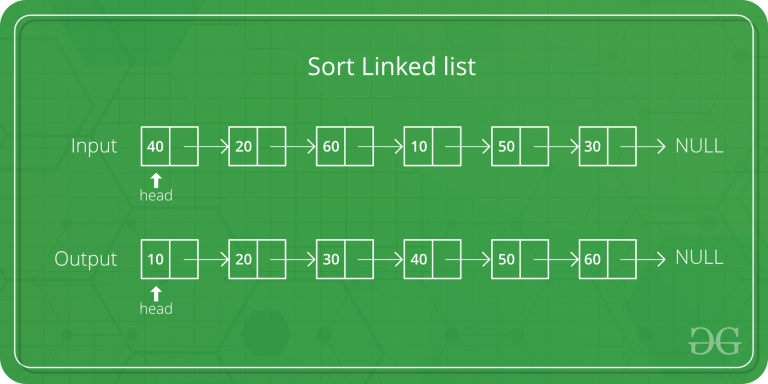Requisito previo: ordenación por combinación para listas vinculadas A menudo se prefiere la ordenación por combinación para ordenar una lista vinculada. El lento rendimiento de acceso aleatorio de una lista enlazada hace que algunos otros algoritmos (como la ordenación rápida) funcionen mal y otros (como la ordenación heap) sean completamente imposibles.  En esta publicación, la ordenación por combinación para la lista vinculada se implementa mediante JavaScript. Ejemplos:
En esta publicación, la ordenación por combinación para la lista vinculada se implementa mediante JavaScript. Ejemplos:
Entrada: 5 -> 4 -> 3 -> 2 -> 1 Salida: 1 -> 2 -> 3 -> 4 -> 5 Entrada: 10 -> 20 -> 3 -> 2 -> 1 Salida: 1 -> 2 -> 3 -> 10 -> 20
javascript
<script>
// Create Node of LinkedList
function Node(data) {
this.node = data;
this.next = null;
}
// To initialize a linkedlist
function LinkedList(list) {
this.head = list || null
}
// Function to insert The new Node into the linkedList
LinkedList.prototype.insert = function(data) {
// Check if the linked list is empty
// so insert first node and lead head
// points to generic node
if (this.head === null)
this.head = new Node(data);
else {
// If linked list is not empty, insert the node
// at the end of the linked list
let list = this.head;
while (list.next) {
list = list.next;
}
// Now here list pointer points to last
// node let’s insert out new node in it
list.next = new Node(data)
}
}
// Function to print linkedList
LinkedList.prototype.iterate = function() {
// First we will check whether out
// linked list is empty or node
if (this.head === null)
return null;
// If linked list is not empty we will
// iterate from each Node and prints
// it’s value store in “data” property
let list = this.head;
// we will iterate until our list variable
// contains the “Next” value of the last Node
// i.e-> null
while (list) {
document.write(list.node)
if (list.next)
document.write(' -> ')
list = list.next
}
}
// Function to mergesort a linked list
LinkedList.prototype.mergeSort = function(list) {
if (list.next === null)
return list;
let count = 0;
let countList = list
let leftPart = list;
let leftPointer = list;
let rightPart = null;
let rightPointer = null;
// Counting the nodes in the received linkedlist
while (countList.next !== null) {
count++;
countList = countList.next;
}
// counting the mid of the linked list
let mid = Math.floor(count / 2)
let count2 = 0;
// separating the left and right part with
// respect to mid node in the linked list
while (count2 < mid) {
count2++;
leftPointer = leftPointer.next;
}
rightPart = new LinkedList(leftPointer.next);
leftPointer.next = null;
// Here are two linked list which
// contains the left most nodes and right
// most nodes of the mid node
return this._mergeSort(this.mergeSort(leftPart),
this.mergeSort(rightPart.head))
}
// Merging both lists in a sorted manner
LinkedList.prototype._mergeSort = function(left, right) {
// Create a new empty linked list
let result = new LinkedList()
let resultPointer = result.head;
let pointerLeft = left;
let pointerRight = right;
// If true then add left most node value in result,
// increment left pointer else do the same in
// right linked list.
// This loop will be executed until pointer's of
// a left node or right node reached null
while (pointerLeft && pointerRight) {
let tempNode = null;
// Check if the right node's value is greater than
// left node's value
if (pointerLeft.node > pointerRight.node) {
tempNode = pointerRight.node
pointerRight = pointerRight.next;
}
else {
tempNode = pointerLeft.node
pointerLeft = pointerLeft.next;
}
if (result.head == null) {
result.head = new Node(tempNode)
resultPointer = result.head
}
else {
resultPointer.next = new Node(tempNode)
resultPointer = resultPointer.next
}
}
// Add the remaining elements in the last of resultant
// linked list
resultPointer.next = pointerLeft;
while (resultPointer.next)
resultPointer = resultPointer.next
resultPointer.next = pointerRight
// Result is the new sorted linked list
return result.head;
}
// Initialize the object
let l = new LinkedList();
l.insert(10)
l.insert(20)
l.insert(3)
l.insert(2)
l.insert(1)
// Print the linked list
l.iterate()
// Sort the linked list
l.head = LinkedList.prototype.mergeSort(l.head)
document.write('<br> After sorting : ');
// Print the sorted linked list
l.iterate()
</script>
Producción
10 -> 20 -> 3 -> 2 -> 1 After sorting : 1 -> 2 -> 3 -> 10 -> 20
Complejidad de tiempo : O(n*log(n))
Espacio auxiliar : O(n)
Publicación traducida automáticamente
Artículo escrito por GeetanshuGulati1 y traducido por Barcelona Geeks. The original can be accessed here. Licence: CCBY-SA